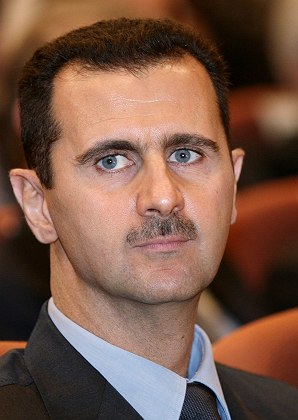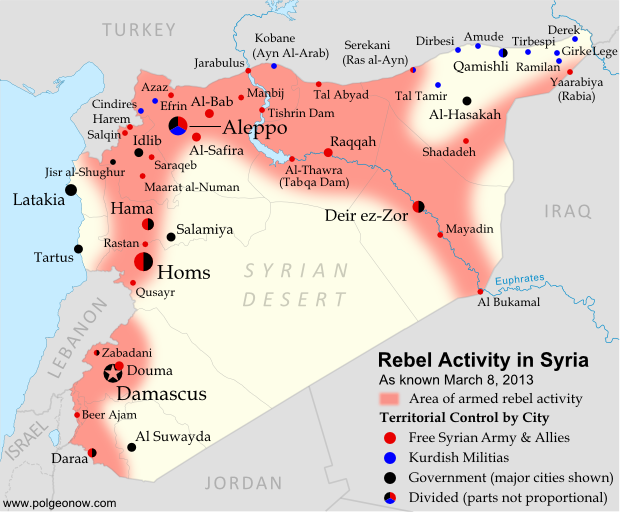The US Strategies for Syria


This week, the Obama administration stated it would begin the process of arming the trusted opposition and may consider many more measures, including possibly, but not yet, a limited no-fly zone over the beleaguered country. But even at this point, the U.S. end game in Syria remains unclear as long as the administration has yet to explain its regional strategic plans regarding Iran and Hezbollah on the one hand and the Salafist Jihadist militias fighting the prior on the other hand. For sending weapons to the opposition, though legitimate and in order to fend off Assad’s Iranian backed forces, raises significant broader questions. Who in the opposition will receive the arms and be responsible for their use? What will be the next steps after the opposition is armed and supplied? Will it be a long haul war between two equal forces with thousands more civilian casualties, or will the equipping of the Free Syria Army (FSA) create a new balance of power that will lead both sides to realize that a military solution is not going to happen and Geneva is the only remaining choice?
Analyzing the regime
Looking at the behavior of the Assad regime, particularly since it took back the city of Qusayr in the center of the country, not only has it broken the opposition’s momentum, but it has moved on the offensive in several areas of the country. In our estimate, the unwillingness of the regime to accept a balance of power with the opposition as a basis for political negotiations, and the unwillingness of Russia to pressure its allies in Damascus and Tehran to accept real power sharing, is what prompted Washington and its allies to beef up the capacities of the anti-Assad coalition and explore the more lethal options of no fly-zones over the country. In short, there is so far no path for a real political solution in Syria, excluding one or the other of the fighting parties. Faced with this reality, the United States must contemplate new strategies regarding Syria’s war that could reshape its entire Middle East policy.
Why take a new path?
In the first months of 2011, when the “Arab Spring” exploded, Washington followed the strategy of shepherding the “rebels” as they made progress against the regimes in North Africa and Yemen. In Tunisia and Egypt, the protesters obtained moral and political support from the Obama administration which enabled them to crumble the pro-American regimes, allowing the most organized among them –the Muslim Brotherhood – to form new governments. In Libya, Qaddafi had no regional allies and was far from Russian logistical supplies. The Obama administration extracted Chapter 7 based U.N. resolution 1973 and launched NATO strikes against the regime until its demise. It worked.
Regarding Syria, the Obama administration decided to let the revolt brew as occurred in Egypt during 2011, hoping that the mass demonstrations would collapse Assad or would at least psychologically convince the Army to move against its own commander-in-chief. It was an erroneous assessment, and a precious year was lost. During the early stages of the revolution in Syria, the movement was led mostly by liberal and secular forces organizing demonstrations, marches and protests in Damascus and several Syrian cities. That year, U.S. forces were still deployed in Iraq and along the borders with Syria. Quick action coordinated with Turkey, Jordan and other partners, in the interest of an erupting civil society would have most likely forced Assad to quit power and seek refuge inside the Alawi region or in Iran. President Obama should have finished the Syria quagmire before Iraq’s pullout. The U.S. was already deployed along Syrian borders with equipment, air force and more importantly, a heavy deterrent against Iran. Assad was practically surrounded; Iran was kept at bay and Turkey was yet untouched by its own protests. Even more significantly, al-Qaeda, via Jabhat al-Nusra, was not yet deeply deployed across the Syrian opposition. The first year of the Syrian crisis, from April 2011 to April 2012, embodied a major U.S. failure in Syria. Washington allowed the landscape to change so dramatically that by early 2013, Syria’s geopolitical realities have changed profoundly.
During the last part of 2012, the tense presidential election campaign in the U.S. prevented a risky decision by the incumbent President to launch any lethal action in Syria for fear of losing constituents both on the left and in the center. That year transformed the terrain irreversibly. Civil demonstrations practically receded, and the street fighting was taken over by ferocious players. On one hand, the regime entered the fray of suppression full force, not only with air force and heavy tanks and artillery, but aided by Hezbollah militias operating out of Lebanon and backed by the Iranian Pasdaran (a subset of the Iranian armed forces) and supplies coming through open Iranian-Iraqi-Syrian borders, open due to the U.S. pullout. The military capacity of the regime multiplied, and its brutality deepened. On the other hand, the Free Syria Army made of offshoots from the regular army had formed, but in parallel, Jihadist militias, including the al-Qaeda linked al-Nusra Front had emerged and spread throughout the various zones of rebellions. The secular and Islamist components of the opposition are hard to distinguish. In addition to the evolution of both sides, chemical weapons were used, even if in a limited manner, by the regime and some have been falling into the hands of the Jihadists.

Facing a great decision
Now in mid-2013, the Obama Administration must make a much greater decision, graver and riskier than those before, but unavoidable. It needs to act, but be able to act at a level equal to the challenges emerging from the many mutations of the conflict. After a crucial battle in Qusayr in central Syria during the month of May, and thanks to the participation of Hezbollah, well-trained special-forces and Iranian military advisors, Assad troops overran the rebels’ positions in the strategic city and the regime moved onto the offensive on several fronts against the opposition. Washington had been hoping, before the Qusayr battle changed the status quo on the ground, that Russia would convince the regime to make dramatic concessions in Geneva. But Assad’s forces leaped forward to crush their opponents in a way that would allow them to use Geneva’s negotiations to their advantage. This, in turn and at last, prompted the Obama administration to approach from a different path, to openly arm the insurgents and possibly set up a no-fly zone over Syrian skies.
The move is in the right direction, but late and slow. Nevertheless, it needs to be developed strategically and comprehensively. Washington’s engagement plans must incorporate vital sub-strategies to address the ramifications of a Syria intervention, regardless of the latter’s scope and size. Here are the main strategic challenges to address:
• Who is and will be the strategic partner inside Syria militarily and politically from start to end? Who will end up seizing ministries in Damascus and impose security and stability once the change occurs? It needs to be clarified before, not as or after the campaign begins.
• What will the Arab participation be in the projected U.S. effort? How far will the Gulf countries, Jordan and also Turkey, go in supporting the campaign, especially if Iran counters these efforts?
• What is the strategic plan of engagement if Hezbollah and Iran respond to U.S. involvement? Is there a Washington global response to an Iranian counter in Syria or in the region?
• Last and not least, what will Syria look like after the Assad regime is gone? A democracy, an Islamist regime or a military government?
It is crucial to understand and evaluate the strategic choices of the United States before the engagement begins so that all actors are aware of the process and of its consequences.